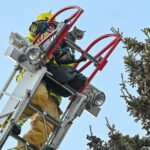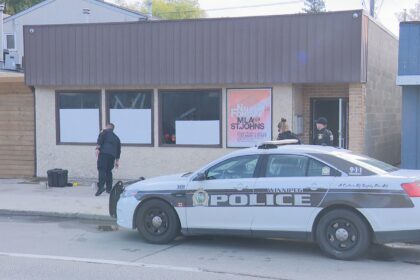The escarpment along Robert Service Way has experienced landslides regularly over the past few springs The City of Whitehorse gave its first briefing of the season regarding the Robert Servce way escarpment landslide risk. The section of the city’s escarpment near the important artery south of downtown has had multiple landslides over the past years, most notably a significant landslide in 2022 which blocked off vehicular and pedestrian access. However, according to the city’s technical team, this year’s circumstances are looking similar to 2024 — a year with a minor slide — in terms of risk. As of right now, there is not anything concerning, said Adam Wallace of Tetra Tech, an engineering firm contracted by the city. However, he said that this is characteristic for this time of year and there is monitoring in place. The current measures in place currently involved hourly photos taken by a slope scanner radar, regular visual inspections from geotechnical engineers, shifting traffic on the road away from the foot of the escarpment, implementing additional block walls if necessary, and initiating the trigger action response plan if necessary. The trigger action response plan is a formalized emergency response plan should there be any slope instability which could impact infrastructure, according to city engineer Rob Dickson. The escarpment stretches across Whitehorse, with twelve zones from Takhini to Robert Service Way: each zone, Dickson said, has its own individual trigger criteria based off of risks and historical data. The response plan also considers the size of the landslides, said Wallace. For example, if there’s indications that a landslide of a similar size to the one that occurred in 2022, the response may look like closing down certain roads or even evacuations in populated areas in the trajectory of this hypothetical landslide. Wallace said nature is unpredictable, but the current monitoring in place would give advance warning of any significant landslide. When landslides occurred during the spring of 2024, said Wallace, they were able to detect signs of movements 10 days in advance. As of right now, Wallace said geotechnical engineers are monitoring the cliff from the top and bottom, as well as on the face of the cliffs themselves where feasible. Inspections are taking place on a weekly basis right now, he said, but the frequency will ramp up as the spring thaw continues. They’re looking for signs of water seepage, cracks forming, and in some cases, actual movement. They also have groundwater monitoring wells near the airport that they are able to check remotely, as well as the aforementioned slope scanner radar photos which are taken every hour. They’ve also installed more monitoring points in Robert Service Way escarpment, specifically areas that had a bit of material fall last year. Wallace said that as the years go on, the 2022 landslide seems to be an anomaly, brought about by specific weather circumstances that year. That said, it could happen again, he said. Barriers close off access to Robert Service Way from the roundabout at Fourth Avenue to just before Yukon Energy following the April 30, 2022 landslide. Also closed are the city’s airport trail and a large section of the Millenium Trail from the SS Klondike to Yukon Energy. (Stephanie Waddell/Yukon News) Anywhere there is a slope, there is potential for movement, said Wallace. In Whitehorse, the areas most likely to see movement are the parts of the escarpment from the Black Street Stairs to Robert Service Way. “That’s where we’ve seen the recent movement happening in the last few years, and even just historically, going back longer into history,” said Wallace. Realigning the escarpment along Robert Service Way has been put forward as the permanent solution to landslides. However, as reiterated by Mayor Kirk Cameron, that solution is a costly one, and comes with a price tag of $60 million. The federal government put up $45 million — three quarters of the project’s budget — but there’s still $15 million that the city is looking for. Cameron told reporters that they’re turning to the territory for that money. He said that he has spoken with both Premier Ranj Pillai and Community Services Minister Richard Mostyn regarding the need for that money in recent days. “This is the largest project we’ve ever undertaken in the history of Whitehorse, and so it would mean some very serious work to make sure that that alignment of federal, territorial and municipal funding would be able to meet the overall requirements,” said Cameron. He credited city staff as working diligently in terms of preparation to ensure that the project’s scope is as tight as possible. However, Cameron did express that while the city is hoping the project can be completed for under $60 million, he’d be glad to see it come in at $60 million on the dot, given the current global economic climate. Cameron did say that the city expects to contribute to the project budget, but that the city would have to dig deep into reserves and look at the city budget to meet the needs of the project. The mayor also confirmed the project will not go ahead until the budget is fully secured. In the meantime, the city has been consistently working on responding to the risk of landslides along the Robert Service Way, said Dickson. He listed the work completed since 2022. The Whitehorse Escarpment Slope Geohazard Study, slope reshaping, as well as the implementation of a sheet pile wall barrier, took place in 2023. The concept design for the slope restabilization was completed in 2024. 2024 also saw the permanent realignment of the Takhini sanitary trunk and the installation of the concrete block wall and jersey barrier wall beside the escarpment along Robert Service Way. Detailed risk assessment is ongoing, as is monitoring along the escarpment, according to Dickson, with special focus towards Robert Service Way. Contact Talar Stockton at talar.stockton@yukon-news.com
Monday, 22 Dec 2025
Canada – The Illusion
Search
Have an existing account?
Sign In
© 2022 Foxiz News Network. Ruby Design Company. All Rights Reserved.
You May also Like
- More News:
- history
- Standing Bear Network
- John Gonzalez
- ᐊᔭᐦᑊ ayahp — It happened
- Creation
- Beneath the Water
- Olympic gold medal
- Jim Thorpe
- type O blood
- the bringer of life
- Raven
- Wás’agi
- NoiseCat
- 'Sugarcane'
- The rivers still sing
- ᑲᓂᐸᐏᐟ ᒪᐢᑿ
- ᐅᑳᐤ okâw — We remember
- ᐊᓂᓈᐯᐃᐧᐣ aninâpêwin — Truth
- This is what it means to be human.
- Nokoma











